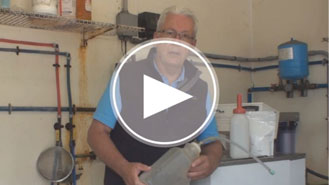
No matter how long you’ve been raising calves, it’s important to help build a solid foundation for each new arrival. “There are four essential elements of newborn calf care that have equal bearing on health and productivity,” says Olson, technical services veterinarian for Milk Products. “Managing these four pillars with careful consistency will help set calves up for future productivity – whether that future is in the milking parlor or the feedlot.”
The four pillars of calf care include:
1. A healthy birth
“A calf’s entry into the world can have a tremendous influence on the rest of its life,” says Olson.
Ensure a healthy delivery:
- Allow the calving process to proceed as naturally as possible. Avoid the temptation to grab a calf and pull if the cow is progressing normally. Many important biological events occur during birth, such as the calf taking control of its circulatory system from its mother. If calving requires intervention, keep the health of the calf and cow in mind.
- Assist calves at birth to ensure they start breathing immediately after the umbilical cord breaks. Clearing the nostrils with a clean towel, a poke of clean straw in the nostril, and/or pouring ice water over the head are all ways to make sure newborn calves take that critical first gasp of air immediately after birth.
“Research has shown the importance of calves being able to sit upright and rest on their sternum within 15 minutes of birth,” says Olson. “If calves are not able to sit up, they will likely need additional care. Discuss with your veterinarian how you can prepare to assist these types of high-risk calves.
2. High-quality colostrum
The importance of delivering critical antibodies to newborn calves – which only can be achieved by feeding colostrum or a high-quality colostrum replacer – cannot be overlooked.
“Unlike some species, including humans, cattle do not pass on maternal immunity in-utero,” says Olson. “Newborn calves need to achieve early immunity through successful passive transfer. The only way they can acquire it is via colostrum.”
There is extensive literature discussing the many aspects of colostrum, but Olson’s “high points” are:
- Harvest clean, biosecure colostrum as quickly as possible after birth. Colostrum quality steadily decreases after birth.
- Aim to administer colostrum to calves at 10 percent of bodyweight within 2 hours of birth.[1] A 90-pound calf would equal 9 pounds of colostrum, or about 1 gallon.
- If quality maternal colostrum is not available, feed high-quality colostrum replacer to deliver at least 150 grams of immunoglobulin (IgG).
3. Optimal nutrition
A fundamentally sound diet can be achieved through several strategies, which Olson advises setting with a nutrition professional.
“Nutrition program goals should focus on the needs of the calf, combined with the needs of your farm,” says Olson. “For example, heifer calves should be fed to reach breeding maturity at a target age. Bull calves, on the other hand, may be fed with a goal of transitioning to dry feed as quickly as possible.”
Other keys to excellent nutrition include:
- Develop a liquid ration with adequate volume, total protein, fat, vitamins and minerals. Think of it as a “liquid TMR.”
- Choose a highly palatable starter grain with a protein level of at least 18 percent. Begin offering small amounts during the first days of life.
- Always provide clean, free-choice water from the first day of life. Water is a critical element for hydration, digestion and rumen development.
4. Ideal environment
Whether you house your calves in hutches, group housing or individual pens, well-managed calves are clean, dry, comfortable and have clean air to breathe.
“It’s important to remember the physical housing structure is just a part of a calf’s total environment,” says Olson.
Don’t forget:
- Bedding choice and management. Clean and fluffy bedding allows the calf to nest. Try to use bedding without a lot of dust and keep calves away from wet bedding.
- Ventilation and air quality. As seasons change, it’s important to remember calf ventilation needs also change. In winter, air should exchange four times an hour and in summer 40 times an hour.
- Sanitation. Everything from pen dividers to feeding equipment should be cleaned. Talk to your advisors about developing a sanitation program.
- Cold weather adjustments. Calf jackets can be very beneficial in cold climates
“Careful attention to each of these pillars will help you build a solid foundation for newborn calves,” says Olson. “If one of the pillars are broken, the entire foundation can collapse.”
For example, calves without adequate colostrum will likely face health challenges that no amount of nutrition can fix. Likewise, a perfect ration can be compromised if it is fed using dirty equipment.
“The farms that I see doing all four of these things successfully, are those that write and regularly review protocols,” said Olson. “That way everyone knows what to do and how to do it, every day. The result is a very solid foundation for every one of their calves.”
Consult your veterinarian, nutritionist or colostrum replacer supplier to learn more about timely and effective colostrum delivery. Learn more about colostrum replacer and whole milk products at CalfSolutions.com.
Milk Products, based in Chilton, Wis., manufacturers high-quality animal milk replacers and young animal health products. Using its innovative manufacturing technology, Milk Products produces over 700 unique animal nutrition products for numerous independent feed manufacturers, wholesale distributors, and large retail chains. Our customers choose whether these products are sold under their private label brand, or under the Sav-A-Caf® brand which is manufactured and marketed by Milk Products.
[1] Dairy Calf and Heifer Association Gold Standards. 2016.



